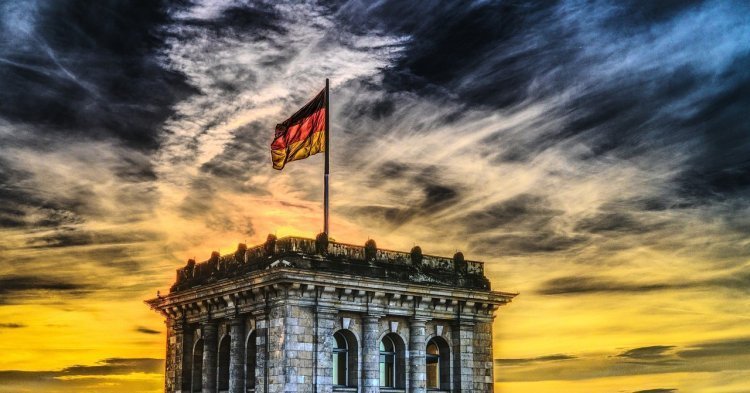A new unexpected geopolitical Revolution
Despite the abolition of the Cold War regime allowed by the new orientation of the Soviet Union under Mikhaïl Gorbatchev, the former leaders were not expecting German reunification to happen so quickly. Already, the fall of the Berlin wall on the 9th of November 1989 created a generalized surprise, despite the East-West détente; however, nobody expected that the two Germany-s would be reunited in the span of 2 months and be made official so early - the 3rd of October 1990. The main obstacle to the reunification was, in 1990, the presence in the ex-GDP’s (German Democratic Republic) territories of hundreds of Red Army’s officers, led by Moscow. The renunciation of the doctrine of limited sovereignty in the Eastern block’s countries, in other words the prohibition made by the USSR to its satellites to get involved in a revision of the principles of Soviet communism, as well as the will of the new soviet power to make a “reset” in its relations with the Western powers made this process easier. So, the agreement of the 16th July 1990 between Mihaïl Gorbachev and Helmut Kohl surprised - once again - most of the chancelleries : in exchange for an important financial contribution of 12 billion Marks and the promise to limit to 370 000 men in the future German armed forces, the Soviet Union agreed to withdraw all of its troops. The agreement definitively opened the way to reunion, which was promptly led with the integration of 5 Eastern Länder to a unified Federal Republic of Germany.
The new Germany and European fears
The Wiedervereiningung recreated an entity populated by more than 80 million people with a highly strategic territory situated at the heart of the continent. This new power had the third biggest GDP in the world and the biggest European population, excluding Russia. Logically, such an upheaval brought back worries about the resurgence of the “German question”. In the West of the continent, particularly, they feared that the reunification could turn the balance of power in favor of Germany. If the re-creation of the army of the Federal Republic of Germany had taken place within the framework of NATO, reunification could only have taken place in the spirit of European integration. To the East, towards the bloodlands, the territories caught in the middle between Nazi and Soviet totalitarianism, were questioning the geopolitical projects of this reunited power located in the heart of the continent. Thus, in Poland, the government chose to postpone the negotiations aiming at the withdrawal of the Red Army to be sure of the validity of German intentions…
This was achieved by the conclusion of a German-Polish agreement, on the 14th of November 1990, relative to the “territorial integrity of the Potsdam border” on the Oder-Neisse. In London, where the diplomatic tradition was an equilibrium between European powers, the declarations of Margaret Thatcher testified her reluctance and stated that “a reunited Germany is simply too big and too powerful to be only an actor like any other” (Memory of Downing Street). Clearly, none of the four powers dealing with the “German question” in 1945 opposed frontally the reunification of the “two Germany-s”. For Washington, the reunion meant the integration of GDR’s territories in NATO ; for London and Paris, it was important to be gentle with Germany and to channel its reunification by integrating it in a into the deepening of the European construction ; the USSR, finally, had renounced to its military presence in the ex-GDR, in exchange for some guarantees and, more generally, to establish cooperative relations with the West.
Fractures still present
The sudden recreation of a unified Germany had logically created questions among its most direct neighbors and even in a country such as France which has made FRG (Federal Republic of Germany) a privileged partner for European construction. The new Germany integrated its new territories into NATO and signed in 1992, next to its European partners, the Maastricht treaty thus creating an European Union and planning the creation of a common currency. The German rebirth did not happen, as Bismarck said, by “iron and blood” but was part of a new spirit of the rule of law and peace, enabling the fast and non-violent integration of the former GDR into Euro-Atlantic structures. However, criticisms appeared in 1990, denouncing the “annexation” of the GDR by the FRG because the unification was not based on a constitutionalist moment among all Germans, but simply on the integration of the Eastern Länder into the institutions of the West. Reunification, as fast as it was, nevertheless left deep divisions within the new Germany. Indeed, more than thirty years after the unification, Cold War fractures had not fully recovered in the country- as shown by the significant electoral disparity between the ex-FRG and ex-GDR territories affected by a rise of the radical right party AfD (Alternative für Deutschland) to the East.
A change of era (Zeitwende) for Germany
Because of its troubled 20th century and of the fears created at the moment of unification, Germany was always principally considered an economic power, thanks to its productive and regulatory system, because of its importance in the European Union. The “change of era” described by Chancellor Scholz after the awakening of war in Europe in 2022, convinced Germany that it should finally assume its political and military responsibilities in Europe. Thirty years after the Wiedervereiningung, the Zeitwende could yet again shake up Germany’s importance in European and global affairs.
This article was translated by Allan Malheiro

Follow the comments: |
|
